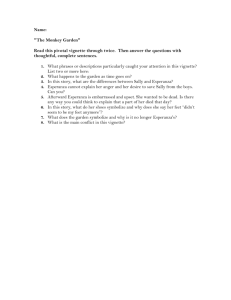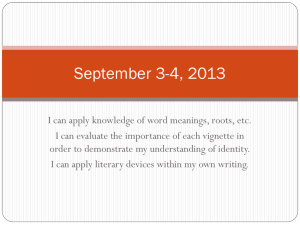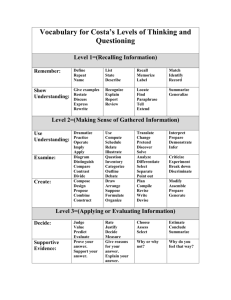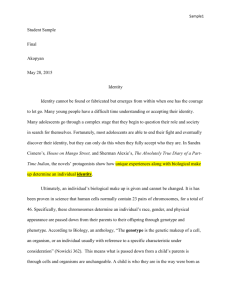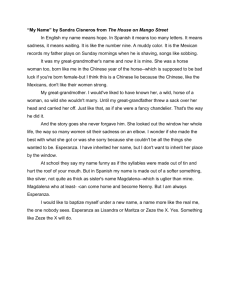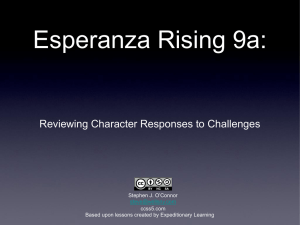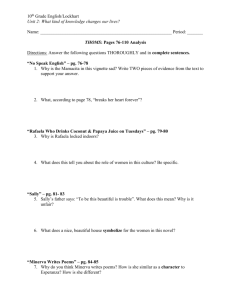House on Mango Street
advertisement
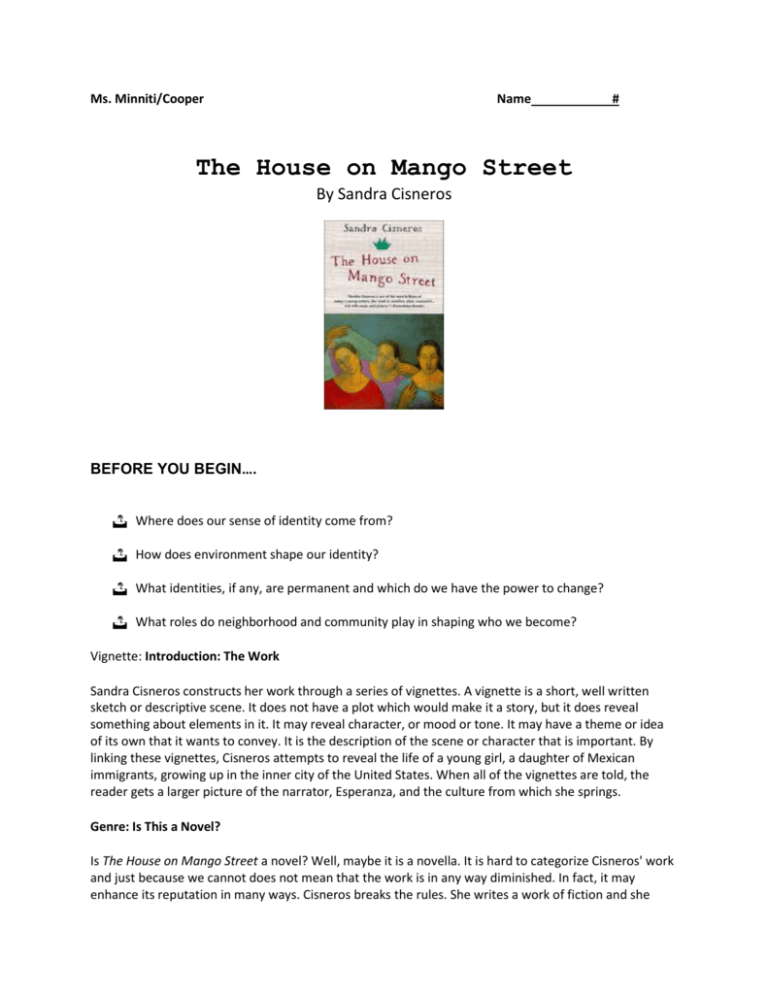
Ms. Minniti/Cooper Name # The House on Mango Street By Sandra Cisneros BEFORE YOU BEGIN…. Where does our sense of identity come from? How does environment shape our identity? What identities, if any, are permanent and which do we have the power to change? What roles do neighborhood and community play in shaping who we become? Vignette: Introduction: The Work Sandra Cisneros constructs her work through a series of vignettes. A vignette is a short, well written sketch or descriptive scene. It does not have a plot which would make it a story, but it does reveal something about elements in it. It may reveal character, or mood or tone. It may have a theme or idea of its own that it wants to convey. It is the description of the scene or character that is important. By linking these vignettes, Cisneros attempts to reveal the life of a young girl, a daughter of Mexican immigrants, growing up in the inner city of the United States. When all of the vignettes are told, the reader gets a larger picture of the narrator, Esperanza, and the culture from which she springs. Genre: Is This a Novel? Is The House on Mango Street a novel? Well, maybe it is a novella. It is hard to categorize Cisneros' work and just because we cannot does not mean that the work is in any way diminished. In fact, it may enhance its reputation in many ways. Cisneros breaks the rules. She writes a work of fiction and she does not follow the conventional rules of plot or form. Is it prose? Mostly, but there are certain chapters which are sort of prose poems ("My Name" or "Geraldo No Last Name" or "Darius & the Clouds"). Because she breaks the rules, Cisneros creates something new and it is up to you to decide if what she has created speaks to you. Breaking the rules is important sometimes, especially when it comes to art, science and creativity. It is why it is important to learn the rules in the first place. Learn what has been done and what has worked well in the past. Learn to use all of the techniques and ideas that others have devised and then you can put them together in new ways. It is a cliché, but we do stand on the shoulders of giants. Experiment. Be brave. (Not everyone will like what you come up with). Learn the rules so that you know where they will take you. Then, IF YOU HAVE A GOOD REASON, break a few. Just make sure you know why you are doing it and are willing to take the risk and brave the consequences. GUIDING QUESTIONS and FOOD FOR THOUGHT: Please write down your thoughts about each question as they come up as you read and as we discuss in class. This will serve as your study guide as well! "Hairs" What is this vignette about? Answer this and don't mention the topic hair. When you have done so, you will have mentioned theme. Exercise: Re-write this vignette and break it into lines as if it were a poem. What are some the most poetic images? "Boys and Girls" This vignette is important! What do you learn about the narrator's culture from the way the children are thought of and the way the children behave? What does this vignette tell about the relationship between males and females? "Until then I am like a red balloon, a balloon tied to an anchor." (9) What is the anchor? What is the thing in her life that is holding her in place? What will free her? "My Name" This is another prose poem. Find some of the important images that refer to how the narrator thinks of herself. What has caused her to think negatively about her name? What do you learn about Esperanza's Mexican culture that was foreshadowed in "Boys and Girls"? "Cathy Queen of Cats" What do you learn about bigotry from Cathy? What do you learn about Alicia? Why do you think Alicia stopped being friendly with Cathy? What do you learn about Esperanza from the way she accepts the stories from Cathy? "Our Good Day" Rachel and Lucy: Who were they in "Cathy Queen of Cats"? What choice does Esperanza make in this vignette? What does it mean? "Laughter" Here is another vignette that is about more than the facts it presents. What is the theme of the vignette? "Gil's Furniture Bought and Sold" What does the astute reader learn about Esperanza from this vignette? "Meme Ortiz" What must it be like to go through life with two multiple names and titles depending upon which language you are using. Which language is Esperanza's? Are you sure? "Louie, His Cousin & His Other Cousin" What is Marin's role in the family? Fill in the missing pieces and explain why Louie's cousin was arrested. "Marin" What does this vignette tell us about the role some women are asked to play in society? What does Marin feel will save her? "Those Who Don't" Does anything that is mentioned in this chapter ring true for you? "There Was an Old Woman She Had So Many Children She Didn't Know What to Do" What is Rosa Vargas' life like? What is the solution? Is there fault? "Alicia Who Sees Mice" Alicia from "Cathy Queen of Cats" is the subject of this vignette. What are some of the obstacles she must overcome to continue to improve herself? How does the culture of her family hold her back? "Darius & the Clouds" What is the theme of this prose poem? "And Some More" Who is the speaker of each line? Can you attach a name to each? What is the destructive element involved in this scene? "The Family of Little Feet" What is happening in this vignette that is so powerful that the girls want to forget that it happened? Where does the power lie? There are many things that are dangerous that are described here. Mr. Benny from the corner grocery notices one danger. Are there others? Think back to "Marin" and "Alicia Who Sees Mice" or look forward in the book follow the character of Sally. What are the dangers are there in Esperanza's world? "A Rice Sandwich" Esperanza tries to be part of something she sees as special. What was the reality of the canteen? Describe Esperanza's shame. "Chanclas" What is the significance of the last two lines of this vignette? Consider the events in "The Family of Little Feet." What is the ambivalence the character has about her growing sexuality? "Hips" This is another story in a series about the burgeoning sexuality of the girls. Why does the author contrast the talk of developing bodies with the songs of the jump rope? What is the purpose of the juxtaposition of these two topics? How has Nenny separated herself from the group? "The First Job" Which quality of Esperanza's personality shows up while she is at her first job? What information do you have from previous stories about Esperanza and other women in the book that would account for Esperanza's shyness and reticence? "Papa Who Wakes Up Tired in the Dark" What phrase does Esperanza use that indicates she feels more an American than a Mexican? "Born Bad" This is the first story to indicate the path of escape for Esperanza. What is it? Who encouraged her? What do you think will be one of your paths to your future? What gift do you have that "will keep you free"? Have you begun "to dream the dreams"? "Elenita, Cards, Palm, Water" Why does Esperanza seek a home? Remember back to "The House on Mango Street." Is there anything in the story to indicate that Esperanza is still a little girl? "Geraldo No Last Name" They never saw the kitchenettes. They never knew about the two-room flats and sleeping rooms he rented, the weekly money orders sent home, the currency exchange. How could they? ((66) If Marin did not know Geraldo very well. If she did not even know his last name, how does she know about his life? Who else has no last name in the story? Why is this so? The use of an anonymous character is a popular technique used by writers. If the character can be anyone then the character can also be the reader. Giving a character a sense of universality is important when the writer wants to impress her theme on the reader. Is Geraldo like you? If you think the answer is No, please think about whether or not you carry any identification with you when you go out. If you were hurt and unable to communicate, would strangers be able to tell who you were? Would you even have a first name? "Edna's Ruthie" The narrator does not know what is wrong with Ruthie. Any answer about her problem would be speculation, but good readers have good speculations. What do you think? "The Earl of Tennessee" Here is a case where the observant reader is smarter than the narrator. Explain the last paragraph of this vignette. "Sire" Again we have the juxtaposition of youth and sexuality. Lois is in a trap. She is involved with something that she does not completely understand. How would you advise Lois? In one ear, Esperanza hears her mother's voice which says that "those girls are the ones that go into alleys." Esperanza also wonders where Sire takes Lois and what happens there. What is the conflict that Esperanza is in? Would you describe the conflict as Esperanza against another person, against herself, against nature, or against society? Who out there could make a case for all four? "Four Skinny Trees" These are the trees mentioned in the previous vignette. Esperanza understands the trees. In fact, everything that Esperanza says about the trees could be said about her. Without using or mentioning the extended metaphor of the trees, tell me all about Esperanza. "No Speak English" What is the sorrow of the woman across the street? Why does she get upset when the baby boy begins to sing the Pepsi commercial? "Rafaela Who Drinks Coconut & Papaya Juice on Tuesdays" Why does Rafaela get locked in doors? What does this tell you about the role of women in this culture? What does this tell you about some of the pitfalls and dangers that Esperanza must avoid? Are these pitfalls very different from the ones you must avoid? "Minerva Writes Poems" Why does Minerva write poems? How is she like Esperanza? How is she different? A cautionary tale is pretty much as it sounds. It is a story that warn or cautions the reader about a danger he might face. How is "Minerva Writes Poems" a cautionary tale? "Bums in the Attic" These chapters are forming a climax to the book. ( I am wary of calling it a novel.) Esperanza is changing both in body (see "Sire") and in aspirations (this vignette). Before Esperanza only wanted a house, but now her dreams have added a new dimension. She is sounding more confident about her success and she has added an altruistic or selfless side to her dream. People who live on hills sleep so close to the stars they forget those of us who live too much on earth. . . . One day I'll own my own house, but I won't forget who I am or where I came from. (86-87) "Beautiful & Cruel" Here is Esperanza at her most confident. She is not like those "who lay their necks on the threshold waiting for the ball and chain." (88) In this poetic image, what does the word "threshold" signify? What is the "ball and chain"? What are the connotations of these two terms? Why does Esperanza emphasize that she will act "like a man"? What does this signify in this story? "A Smart Cookie" Here we have another cautionary tale and this one is told to Esperanza by her mother. Esperanza's mother warns her about refraining from participating in life because of shame. Refraining from life will only perpetuate the shame is her lesson. Explain the significance of the last sentence: "I was a smart cookie then." "What Sally Said" What are the dynamics between the father and Sally? Why does Sally leave home? Why does she go back home? Why does her father hit her? Why does Sally leave home? "The Monkey Garden" This is a complex and important chapter. Read it carefully! First we have a garden. Could this be an allusion to another garden? What famous gardens do you know? Next we have a description of the garden that the children take over. Describe it when they first have it. What happens to the garden as time goes on? Things had a way of disappearing in the garden, as if the garden itself ate them, or, as if with its old-man memory, it put them away and forgot them. (95) Let's go back to what we were learning about theme. The plot of this chapter is about a garden, but a good story is always about something other than the plot. If this story is about something more, then what might the garden be all about? On page 96, Esperanza tells the reader that this was a place she wanted to die and where she tried to die. She indicates that this would be the last day she would be in the garden. Therefore the events that follow this must be significant. You are being told to pay attention. Will you? Following this attention getting paragraph, Esperanza asks, "Who was it that said I was getting too old to play the games?" If this immediately follows the attention getting paragraph, this question might be important. What is the story about? In this story, Esperanza is contrasted with what other character that we have been getting to know? In this story, what are the differences between Sally and Esperanza? Esperanza witnesses some interplay between Sally and Tito and the boys. Esperanza becomes angry in a way that seems out of proportion to what is happening. The action between Sally and the boys must represent something more important to Esperanza. What is it? Esperanza can not explain her anger and her desire to save Sally from the boys. Can you? Afterward Esperanza is embarrassed and upset. She wanted to be dead. Did she die? Is there any way you could think to explain that a part of her died that day? What part might it be and how did it happen? I looked at my feet in their white socks and ugly round shoes. They seemed far away. They didn't seem to be my feet anymore. And the garden that had been such a good place to play didn't seem mine either. (98) A symbol is an object that represents a much, much, much, much, much, much more complicated idea. Remember the shoes Esperanza is referring to. She mentions them in "Chanclas." In this story, what do the shoes symbolize and why do they no longer seem to be her feet anymore? What does the garden symbolize and why is it no longer Esperanza's? Sally does not seem to a part of the garden in this story. Did she leave the garden in the same way as Esperanza? What is the conflict in this story? There is a great deal to talk about in this story, but much of it depends upon the previous chapters and what the reader learns there. "Red Clowns" What happens to Esperanza in this chapter? In what way is she different from Sally? Why is she different from Sally? Will she ever become like Sally? "Linoleum Roses" What is Sally's fate? "Three Sisters" This vignette seems to take on a mystical element absent in any of the other chapters, even "Elenita, Cards, Palm, Water" which was ostensibly about fortune telling. this story seems to be about something truly mystical. At a funeral, Esperanza meets three old aunts at a baby's funeral. Three sisters they are called and one cannot help thinking of the Three Weird Sisters who were fortune telling witches from William Shakespeare's Macbeth. They ask Esperanza to make a wish and she does, but does not tell them what it is. (What do you think it is?) The sisters tell Esperanza that the wish will come true but they add an admonition or warning. After repeating Esperanza's name, one sister says, When you leave you must remember to come back for the others. A circle, understand? You will always be Esperanza. You will always be Mango Street. You can't erase what you know. You can't forget who you are. . . . You must remember to come back. For the ones who cannot leave as easily as you. (105) Why does the sister repeat Esperanza's name? The climax of the story has been over for several chapters. We are into the denouement. What was the major conflict of the story? If you are having trouble figuring out the conflict and who won, answer this question, "How do you know Esperanza will never end up like Sally?" Who won the conflict and when did it happen? (Only answer this if you have already finished the book.) What is this story telling us about the fate of Esperanza? "Alicia & I Talking on Edna's Steps" Who is Alicia? What is significant about her and why is she talking to Esperanza? Recall Alicia in "Cathy Queen of Cats" and "Alicia Who Sees Mice." What is this chapter telling you about the fate of Esperanza? Who is going to make Mango Street better? How? "A House of My Own" How will Esperanza make a house of her own? What confidence is Esperanza showing? What is the significance of the simile in the second paragraph? "Mango Says Goodbye Sometimes" Where did Esperanza go? How? Why? Name_____________________________ Theme & Writer’s Craft Activity House on Mango Street - “There Was an Old Woman” through “Born Bad” Directions: Using the model below, complete the rest of the assignment sheet describing what you believe a theme to be for each vignette and thinking about author’s craft. Each team will complete 4 of the vignettes organized below. For theme, you are discussing a “big” idea that Esperanza (or Cisneros) is trying to show the reader through the vignette. For writer’s craft, you are using Cisneros’ language to show how she makes these ideas come alive or stick in the reader’s mind. Use your purple writer’s craft sheet with imagery, alliteration, personification, etc., definitions on it. Sample: “There Was An Old Woman. . .” Theme: Writer’s Craft: When one loses respect for himself, he no “who is tired all the time from longer has respect for anyone else or buttoning and bottling and babying” anything else. People then start to give (page 29) - alliteration up on each other. I think Cisneros uses alliteration here to make the reader feel burden or the weight of this mother’s job. With all the kids, her jobs are never ending. The “b” sound is heavy, like and motor sound—heavy like her responsibilities. “Alicia Who Sees Mice” Theme: Writer’s Craft: “Darius & the Clouds ” Theme: Writer’s Craft: “And Some More” Theme: Writer’s Craft: “The Family of Little Feet” Theme: Writer’s Craft: “A Rice Sandwich” Theme: Writer’s Craft: “Chanclas” Theme: Writer’s Craft: “Hips” Theme: Writer’s Craft: CREATIVE WRITING PROJECT Sandra Cisneros tells her readers that she decided to write her novel, The House on Mango Street, because "you will always be Mango Street. You can't erase what you know. You can't forget who you are." The purpose of this project is to create your own book which will help you remember what you know, as well as show others who you are. Your book must have the following items: * An Original Cover * Title/Title Page * Dedication * Table of Contents * 6 Chapters (see below) TOTAL POSSIBLE: Note: You will NOT receive ANY POINTS AT ALL for any book that is turned in that has less than 3 completed chapters. Your chapters must be chosen from the following subjects: Your Name Your Neighborhood Games or Favorite Toys from your Childhood A Time You Got Into Trouble A Time You Saw Someone Else Get Into Trouble Advice From an Adult A Positive Story From Your Experiences at School A Negative Story From Your Experiences at School A Special Family Member A Happy Time For You Going to Work A Special Holiday A Special Birthday The Big Game A Birth Life in northern Illinois 1 Additional Chapter on anything you wish Chapter length: A chapter under 100 words will be considered underdeveloped and will not receive the full 10 points per chapter. The chapters can be in any order you choose as long as it follows your Table of Contents. While we will spend some time in class, you should expect to do most of this project at home.
